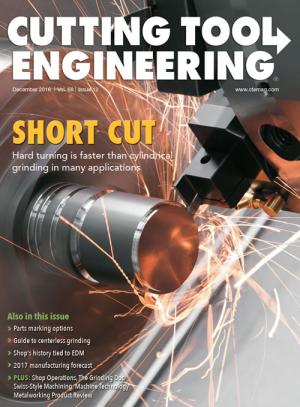Dear Doc: The grinding wheel manufacturer I work for wants to set up a basic lab for testing wheels and different Al2O3 grits. What’s the best, most-economical way to do this?
The Doc Replies: For starters, you’ll need a basic new or used surface grinder, with automatic down feed and at least a 5-hp motor; a power meter that gives power (not current) in horsepower (not amps); a data-acquisition system that can log at least 20 samples per second; and a vise and a razor blade for measuring wheel wear.
Somebody may try to sell you a dynamometer, but don’t bother. A dynamometer is only slightly better than a power meter, but costs much more and requires special fixturing. In most cases, a power meter will give you 90 percent of the information at 10 percent of the price and 5 percent of the hassle.
Generally, a basic, water-based flood-cooling system will be fine. For testing water-based coolants, you’ll need a 75-psi pump and an enclosed system. For testing oil-based coolants, you’ll need an enclosed system and fire-suppression equipment.
Next, you’ll need a way to consistently dress wheels. It doesn’t matter how you do it (single point, cluster, blade, diamond roll) or where the dresser is located (above the wheel, mounted on a magnet), as long as you achieve a consistent, repeatable traverse velocity for every dress.
Now comes the hard part: 90 percent of the battle involves setting up testing parameters. When testing grits, for example, one grit may show markedly improved or degraded performance compared to another grit, depending on the chosen speed and feed. Here, you must find the “stable regime” of grinding. Ideally, you’ll test each wheel at several speeds and feeds to provide a suitable comparison. Also, don’t just run a single test; do a “transient test.” This means you grind a large amount of material and see how the power changes over time.
There are some caveats. First, don’t think you’re going to replicate a customer’s grinding operation. The differences between your customer’s and your setup include coolant type, dressing method and spindle stiffness. Replication can be done, sort of, but it takes a lot of homework and preparation. Second, be prepared to invest some time. An effective test can take 2 days for setup, a day for testing and 3 days for processing. Third, expect ambiguous results. One wheel may work better under a given set of conditions, but worse after just changing the DOC. That’s fine, as it’ll allow you to understand how a grit behaves, but you’ll need a solid grasp of grinding to draw those conclusions. Nonetheless, grit and wheel testing can give good information. You’ll need to learn how to set up the program, how to measure wear with the razor blade, how to choose meaningful speeds and feeds and—most importantly—how to interpret the results.
Dear Doc: I’m getting chatter on parts and am trying to determine if it’s from grinding forces that are too high or from an out-of-balance wheel. Is there a way to tell?
The Doc Replies: Yes, by changing your wheel speed. Grind one part at, say, 2,000 rpm and another at 3,000 rpm. If the chatter marks get closer together, it points toward—but by no means confirms—an out-of-balance wheel. If the marks stay the same distance apart, it points toward—but by no means confirms—self-excited chatter, which can be caused by normal forces that are too high.
Related Glossary Terms
- chatter
chatter
Condition of vibration involving the machine, workpiece and cutting tool. Once this condition arises, it is often self-sustaining until the problem is corrected. Chatter can be identified when lines or grooves appear at regular intervals in the workpiece. These lines or grooves are caused by the teeth of the cutter as they vibrate in and out of the workpiece and their spacing depends on the frequency of vibration.
- coolant
coolant
Fluid that reduces temperature buildup at the tool/workpiece interface during machining. Normally takes the form of a liquid such as soluble or chemical mixtures (semisynthetic, synthetic) but can be pressurized air or other gas. Because of water’s ability to absorb great quantities of heat, it is widely used as a coolant and vehicle for various cutting compounds, with the water-to-compound ratio varying with the machining task. See cutting fluid; semisynthetic cutting fluid; soluble-oil cutting fluid; synthetic cutting fluid.
- dressing
dressing
Removal of undesirable materials from “loaded” grinding wheels using a single- or multi-point diamond or other tool. The process also exposes unused, sharp abrasive points. See loading; truing.
- dynamometer
dynamometer
When drilling, a device for measuring the generated torque and axial force (thrust). When milling, a device for measuring the generated torque and feed force. When turning, a device for measuring the tangential, feed and radial forces.
- feed
feed
Rate of change of position of the tool as a whole, relative to the workpiece while cutting.
- grinding
grinding
Machining operation in which material is removed from the workpiece by a powered abrasive wheel, stone, belt, paste, sheet, compound, slurry, etc. Takes various forms: surface grinding (creates flat and/or squared surfaces); cylindrical grinding (for external cylindrical and tapered shapes, fillets, undercuts, etc.); centerless grinding; chamfering; thread and form grinding; tool and cutter grinding; offhand grinding; lapping and polishing (grinding with extremely fine grits to create ultrasmooth surfaces); honing; and disc grinding.
- grinding wheel
grinding wheel
Wheel formed from abrasive material mixed in a suitable matrix. Takes a variety of shapes but falls into two basic categories: one that cuts on its periphery, as in reciprocating grinding, and one that cuts on its side or face, as in tool and cutter grinding.
- stiffness
stiffness
1. Ability of a material or part to resist elastic deflection. 2. The rate of stress with respect to strain; the greater the stress required to produce a given strain, the stiffer the material is said to be. See dynamic stiffness; static stiffness.


